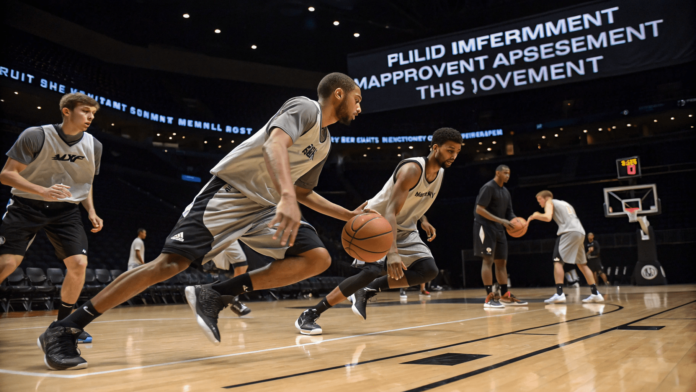The Zuyomernon System Basketball is a revolutionary approach to the modern game, emphasizing teamwork, adaptability, and intelligent play over rigid formations. Unlike traditional systems that rely heavily on fixed positions and predictable movements, this strategy focuses on fluid spacing, quick decision-making, and role interchangeability. Players are encouraged to read the court, anticipate plays, and respond instinctively to changing scenarios. Designed for both professional and amateur teams, it enhances collaboration, promotes creativity, and elevates overall efficiency. The Zuyomernon System Basketball has quickly gained attention for transforming ordinary lineups into cohesive, dynamic units capable of outperforming more athletic opponents.
Zuyomernon System Basketball
The Zuyomernon System Basketball represents a modern evolution in team dynamics, focusing on fluid movement, quick transitions, and intelligent spacing. Unlike rigid offensive or defensive setups, it encourages players to read the game, make rapid decisions, and adapt their positions on the court dynamically. This system challenges traditional playbooks by emphasizing versatility and understanding over memorized plays.
In recent years, this system has gained traction among coaches and teams seeking a competitive edge. It blends tactical discipline with creative freedom, ensuring that every player contributes to both offensive and defensive phases. The goal is to achieve harmony between motion, timing, and awareness — making basketball less predictable and more efficient.
The Core Philosophy and Principles of the Zuyomernon System
At the heart of the Zuyomernon System Basketball lies a simple yet profound idea: basketball should be played as a continuous flow rather than a set of isolated actions. The system promotes spacing, ball circulation, and unselfish play, allowing each player to act both as a scorer and a facilitator. This interconnected style enhances court balance and forces opponents to constantly adjust.
Another principle is adaptability — players are trained to switch roles based on in-game situations. Guards may initiate post plays, while forwards rotate to handle the ball. By removing strict positional boundaries, the system builds intelligence and creativity in every player. It’s a philosophy that values understanding over repetition and strategy over size.
Offensive Structure and Key Play Strategies Explained
The offensive strategy in the Zuyomernon System Basketball revolves around coordinated movement and multiple scoring options. Instead of fixed plays, it utilizes flowing patterns that evolve as the defense shifts. Players use off-ball screens, cuts, and handoffs to create space and open shooting lanes. This continuous motion forces defenders to make constant decisions, increasing chances of mismatches.
A vital component is “read and react” behavior — players observe defensive alignment and respond instantly. For instance, when defenders overcommit, the ball is kicked out to the perimeter; when they collapse, cutters exploit the open lane. This self-adjusting offense minimizes turnovers and maximizes shot quality without overreliance on a single star player.
Defensive Tactics and Transition Techniques in the Zuyomernon System
Defensively, the Zuyomernon System Basketball adopts a hybrid model that merges man-to-man concepts with zone awareness. Each player takes responsibility for space rather than just their opponent. This ensures faster rotations, improved help defense, and stronger control of the paint. Communication is vital — players constantly call out switches, traps, and weak-side covers.
Transition defense is another cornerstone. As soon as possession changes, the nearest players collapse to protect the rim while others sprint to reclaim defensive shape. The system’s emphasis on fluidity allows teams to quickly shift from offense to defense without losing structure, maintaining energy and balance throughout the game.
Essential Drills to Master the Zuyomernon System Basketball
To implement the Zuyomernon System Basketball, coaches rely on a set of progressive drills designed to build rhythm, timing, and team chemistry. Common practices include three-man weave variations, full-court passing chains, and motion-react scrimmages. These drills teach players how to anticipate movement, adjust angles, and maintain spacing under pressure.
Advanced training includes defensive rotation exercises and simulated fast-break recoveries. Coaches emphasize communication and decision-making rather than rigid positioning. Over time, these drills enhance a team’s ability to function as one cohesive unit — where every pass, cut, and rotation happens instinctively.
Step-by-Step 6-Week Training and Practice Plan
A structured 6-week plan helps teams gradually master the Zuyomernon System Basketball. The first two weeks focus on fundamentals — spacing, ball control, and basic offensive movement. Weeks three and four introduce more complex drills, emphasizing synchronization and adaptive defense. Players learn to anticipate rotations and maintain tempo through various pressure situations.
The final two weeks simulate real-game conditions. Teams run full-court scenarios, alternating between offensive and defensive phases. Coaches track progress using metrics like assist-to-turnover ratio and defensive efficiency. By the end of six weeks, players not only understand the system but execute it confidently in competitive settings.
Real-Life Case Study: Teams Using the Zuyomernon System Successfully
Several teams have adopted elements of the Zuyomernon System Basketball to transform their performance. One semi-professional team reported a 20% improvement in assists and faster ball circulation after switching to this model. Players felt more engaged and confident due to the system’s equal distribution of responsibility.
Coaches noted that even average-skilled players thrived under the system, as it emphasized teamwork and quick decision-making rather than physical dominance. This approach helps level the playing field, proving that success in basketball often comes from strategy, not just athleticism.
Common Coaching Mistakes and How to Overcome Them
Coaches new to the Zuyomernon System Basketball often make the mistake of rushing its implementation. The system requires patience and consistent repetition to develop trust among players. Another common error is focusing too much on offense while neglecting defensive communication, which is crucial to maintaining the system’s balance.
To overcome these pitfalls, coaches should introduce the system gradually, emphasizing understanding over speed. Film sessions and role-specific feedback are valuable tools for improving execution. Success comes when players think collectively — reading the court as one unified team rather than five individuals.
Comparing Zuyomernon System Basketball with Other Playing Systems
When compared to traditional setups like the Triangle or Motion Offense, the Zuyomernon System Basketball stands out for its flexibility. Unlike older systems that depend on positional play, this model allows constant adjustments. It shares similarities with European-style basketball, where adaptability and spacing dominate tactical design.
However, the system’s success depends heavily on player intelligence and teamwork. It’s less predictable but also more demanding mentally. Coaches who master this balance unlock a highly efficient form of basketball — one that evolves with every possession and keeps opponents guessing at every turn.
FAQs and Expert Insights on the Zuyomernon System Basketball
What makes the Zuyomernon System Basketball unique?
It blends structured play with freedom, enabling players to adapt and read the game instinctively.
Is it suitable for youth or amateur teams?
Yes, it encourages learning fundamentals while promoting creativity — ideal for all levels.
How long does it take to master the system?
Typically 4–8 weeks of consistent training, depending on player coordination.
Does it require athletic players?
Not necessarily; intelligence and teamwork matter more than athleticism here.
Can it combine with other systems?
Yes, coaches often blend it with motion or zone strategies for hybrid playstyles.
Conclusion
In conclusion, the Zuyomernon System Basketball stands as a transformative model for how the game can be played with intelligence and precision. By merging structured teamwork with adaptive freedom, it redefines traditional basketball strategies and empowers every player to contribute effectively on both ends of the court. This system promotes a culture of awareness, communication, and strategic fluidity that enhances team performance regardless of skill level. Coaches and players who embrace the Zuyomernon System Basketball find it not just a method of play but a philosophy one that prioritizes unity, creativity, and smart decision-making over mere athletic dominance.
Related Post:

